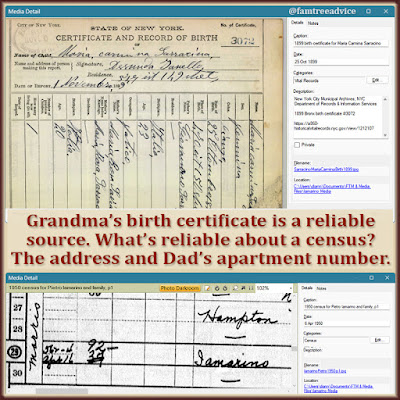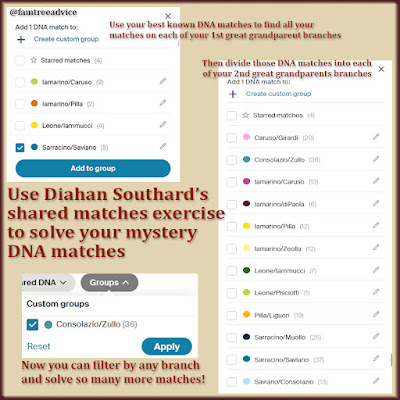I'm so close to finishing the source citation clean-up project I started in January. It's been massive. My tree has more than 57,000 people, so I have tons of citations. And this review doesn't include my 1,000s of Italian vital record citations. I'll get to them next.
This review involves making sure each citation has:
- facts about the source
- specifics of the citation
- a link to the record, and
- an image if available.
Also, importantly, I'm making sure citations get shared, not duplicated. For example, bad Ancestry syncs caused one census citation for a family of 8 to split into 8 source citations. It was mayhem. That ends now.
I went through my source list alphabetically. But I saved a few big ones for last. They included the:
- Social Security Death Index (SSDI)
- Social Security Applications and Claims Index
- U.S. Public Records Indexes, volumes 1 and 2
- U.S. City Directories
- Find a Grave
For my U.S. Public Records Index source citations, my goal was to delete each one where I had a better source. Why? Because too many times I've seen this source say that a person's birthday was the 1st of the month when I knew better. These were estimates. They were definitely not reliable. So, if I had a reliable source for someone's birthday, I deleted their Public Records Index citation.
 |
| When you have a handful of sources telling you the same facts, do you need them all? |
The Most Reliable Sources
Most of my family lived in New York City until the last several decades. That means I have access to many of their birth, marriage, and death records online. These are big clear images of the documents themselves. They haven't been available online for long, so I'm still finding and downloading more and more.
Actual vital record images are very reliable for dates and places. I know my maternal grandmother was born on 25 Oct 1899 even though her grave marker purposely says 1900. Names are subject to spelling errors and variations, but if you keep an open mind, you can gather what you need.
If I have an image of a relative's vital record, any other source that happens to be correct is a supporting source. And some supporting sources are more respected than others. I'm putting my faith in the birth record written on the day. If the SSDI happens to have the same date, it's a nice supporting source. But if a Public Records Index happens to be right too, do I need to cite it? Not if I have the real thing. It's not a reliable source, and it adds nothing.
U.S. WWI and WWII draft registration cards are well respected sources, too. Of course your relatives born in the late 1800s may not be 100% certain about their birth date. So mistakes can happen. But if you've got a young man born in the 1920s registering for the WWII draft, I'd bet he knows his birth date and won't make a mistake.
Post-1890s ship manifests can be reliable, especially for identifying hometowns. Naturalization papers often have a lot of correct dates and places. These are both great to have when they support your most reliable sources.
 |
| Make sure you're choosing the most reliable sources for your family tree facts. |
Less Reliable Sources
My own birth is on Ancestry.com as an image of a New York City index page. It's not a very clear image, so the certificate number is open to interpretation. And I didn't have a first name on day one, so how could anyone be sure Female Iamarino is me?
Last year I ordered my paternal grandmother's upstate New York birth certificate. I hope I got the certificate number right. She's listed as Female Merino instead of Lucy Iamarino, which is why I couldn't find her for so long. I'm eager to get the certificate to finally confirm her birth date. If it's really the 10th, my dad had it wrong his whole life. And my son was born on her birthday, but we never knew it! My son is 30.
When you have a bad index image or a database of facts pulled from indexes, it can't compare to seeing the original document.
The 1900 U.S. census includes the month and year of each person's birth. How nice! But that's only as reliable as the person who talked to the census taker. A census is a reliable source for home addresses, but not much else. The censuses are fantastic supporting documents unless they have a glaring error.
When I went through my U.S. Public Records Index citations, I planned to keep them only if they were my only source for a name, birth date, or death date. I whittled the citations down from 132 to 37. Most of what I kept is the only source I can find for a contemporary person's date of birth.
The two domestic sources I have left to review are U.S. City Directories and Find a Grave. I love when I find a grave marker image or an obituary on Find a Grave, but I know they're not reliable. My grandmother's grave marker says she was born in 1900 because she hated that she was born in 1899. My aunt told me she requested it that way because otherwise "my mother would kill me." And an obituary writer may not have the facts straight.
I'm sure I'll keep every Find a Grave source citation because they're often the only way to know where someone is buried. But if they disagree with a birth or death date from a reliable source, I won't attach the Find a Grave citation to that fact.
You may not want to launch a months-long review of all your citations, so here's what you can do. Each time you're working on a particular family unit, take a good look at all your citations for them. Can you find a more reliable source for key facts? Is what you have a most reliable source, a solid supporting source, or a less reliable source?




